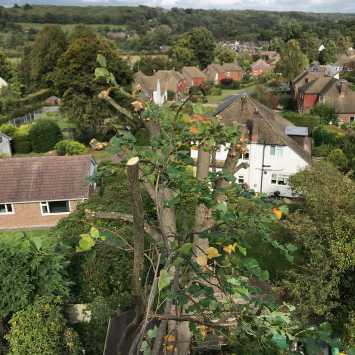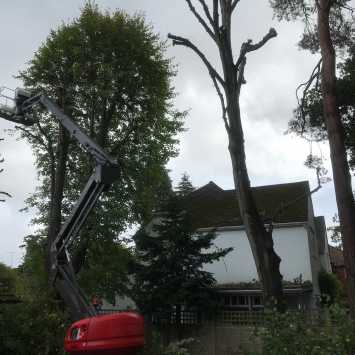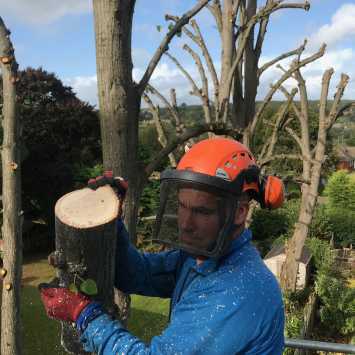The W@H Regulations 2005 have been around for a long time, it’s coming up for 15 years, however, there is often confusion as to how they apply and what they mean. This is partly due to the overlap of all the H&S regulations and the treatment of the regulations in the City & Guilds units in two separate sections. This article outlines the City & Guilds NPTC schedule questions around the Work @ Height Regulations and relates these to a practical tree job we recently completed.
Recent developments in climbing systems and the popularity of Stationary Rope Work Positioning systems has re-opened a ‘can of worms’ for our industry, specifically on the exact requirements for back up lines, when using work positioning or a rope access techniques. (see the previous blog) This has mainly been settled since the inception of the Regs and the industries determination of rope access & positioning report at least in terms of the reliance of one rope system as per the Schedule 5, Part 2 (c):
where it is not reasonably practicable to comply with subparagraph (a), all practicable measures are taken to ensure that the work positioning system does not fail.
This focus on the detailed requirements can cloud the bigger picture of whether we should be at height at all, and if we must, whether a fall prevention solution should be used.
The Work @ Height Regs came into force following a period of frequent accidents and injuries from falls from height, especially in construction, despite a raft of existing legislation and regulations, notably:
H&S at Work Act 1974 – General duty to provide & maintain a safe place of work
- PUWER 98 – Suitable equipment selected, training & maintenance
- LOLER 98 – Planning & Managing Lifting Operations & Equipment inspections
- Management of Health & Safety Regulations 1999 - Risk Assessment
In C&G Aerial Units (Tree climbing and aerial rescue/ Aerial cutting/ Aerial Pruning/ Aerial Rigging), the emphasis is on the following points the link to the relevant existing legislation is given in brackets.
- all work at height is properly planned and organised (LOLER)
- those involved with work at height are competent (PUWER)
- the risks from work at height are assessed and appropriate work equipment is selected and used (Management Regs)
- equipment for work at height is properly inspected (LOLER)
Rescue provision is not mentioned here but might be included in the emergency planning section earlier on.
The assessment schedule follows this with a question about the Work @ Height assessment, often in response to tree condition, and this logically leads to a question over whether climbing is appropriate. This refers to the Work @ Height hierarchy, and this can be a confusing time for students, who find themselves on a climbing course asking whether they should be climbing. A previous article covered the hierarchy in detail. Since the publication of the Industry Code of Practice for Arboriculture, there has been an increasing awareness of using systems higher up the hierarchy such as platforms.
We often present the requirements of the Work @ Height Regs as shown in the NPTC schedule as a reminder to do what should already have been done, if you’d complied with the earlier Regulations.
Work at Height Assessment should consider:
- avoid working from height where possible (e.g. using pole pruners)
- use work equipment or other measures to prevent falls (e.g. MEWP use)
- use work equipment or other measures to minimise the distance and consequence of the fall (e.g. tree climbing)
A recent practical tree job is outlined to illustrate the wider context/principle of working through the Work @ Height hierarchy.
Our client’s lime tree screen, composing of 4 trees along the boundary of his property, had been pruned previously, after a long period of neglect. Looking at the tree form, it was apparent that they were maintained or cut to lower positions historically, and had most recently been cut to around 16m.
With about 3-4 meters of re-growth, the client now wanted to manage them more regularly – minimising shading and obstruction of adjacent buildings/ gardens/ neighbours.
After viewing the trees again, I took the view that a platform would work well and help overcome some problems with as wholly climbing based solution. The following questions work through the hierarchy:
- Can work be done on the ground?
No, only parts could be reached with telescopic pruners. Even if felling, limited space would be a factor, but the client wanted the trees retained and they were covered by a group TPO
- Can a fall prevention system be used?
For us here, that meant a MEWP – but it might mean a scaffolding solution on a long hedge. As access was good at the front with a hard, gravel drive, clear space, 2-3 trees were reachable, so the answer was partial. However – MEWP access was not possible for the rear tree unless a tracked machine was selected, leading to issues of lack of reach and mobility, so we decided to use a self-propelled boom with a maximum working height of 18m and outreach of 8m, to access the majority of the three trees.
- Use systems that minimize the distance and consequence of a fall – that means work positioning here, and this was appropriate for the one tree in the back of the property.
- Use none of the above such as ladders, which in conjunction with a pre-placed access line offered ergonomic benefits in climbing the first section.
Using only a MEWP was not an option, so a pragmatic approach was to mix two solutions from adjacent levels in the W@H hierarchy.
Poorly specified MEWPS can be a significant problem, with either a lack of height or reach and insufficient clear drop zone below without risk of damaging outriggers. The considerable time and effort to de-rig, move and set up can interrupt the workflow and lead to rushing or abandoning the MEWP in favour of climbing.
Self Propelled Boom machines if the site has sufficient space and suitable hard surface offered a lot of benefits instability and mobility with the ability to change position from an elevated operator position.
For this job having a MEWP on-site also allowed the option of placing a climber at or near the top of the tree to access the problematic parts using a conventional system. Because of the tree form with long vertical blank sections climbing would have been difficult to advance the rope and also achieve appropriate work positions.
Consideration of the re-pollard work type here meant multiple small cuts, which would have been very time consuming to rig, so we used handheld cuts and then a drop zone.
We hope the above example helps to clarify how the Work @ Height Hierarchy can be applied in a real work situation.




